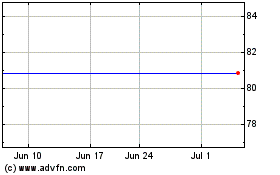St. Jude Medical Announces European Approval for Industry-First Neurostimulation Lead Delivery System for the Management of C...
May 27 2010 - 8:00AM
Business Wire
St. Jude Medical, Inc. (NYSE:STJ), a global medical device
company, today announced European CE Mark approval of its new
Epiducer™ lead delivery system for neurostimulation therapy.
Unveiled at the Neurosurgery 2010 Congress in Lyon, France, the
Epiducer lead delivery system is the first of its kind, allowing
introduction of S-Series perc-paddle leads as well as multiple lead
arrays through a single percutaneous entry point.
This innovative lead delivery system is designed to reduce
procedural complexities. The Epiducer system allows physicians to
efficiently place neurostimulation S-Series perc-paddle leads
and/or multiple lead arrays utilized in spinal cord stimulation
(SCS) therapy for the management of chronic pain. Before the
Epiducer system, the placement of paddle leads was only possible
through a laminotomy, a more invasive surgical procedure, which
typically requires removal of part of the vertebral bone.
“One of this system’s advantages is that it enables a physician
to introduce a perc-paddle lead into the epidural space with a
simpler, less invasive procedure,” said Dr. Olivier De Coster, an
anesthesiologist who is head of the Pain Clinic at the Stedelijk
Ziekenhuis Hospital in Roeselare, Belgium. “Paddle leads provide
numerous therapy benefits including greater stability for reduced
risk of migration and more efficient unidirectional
stimulation.”
Neurostimulation therapy is used for managing chronic pain of
the trunk and limbs and pain from back surgeries that have failed.
A paddle lead is a small insulated wire with multiple electrodes on
a flat paddle-shaped surface that is placed in the epidural space
near the spine. Mild electrical pulses are carried from the
neurostimulator to the lead’s electrodes to interrupt or mask the
transmission of pain signals to the brain. Electrodes on the lead
can be programmed to meet each individual patient’s needs.
“We are pleased to provide physicians with this next-generation
lead delivery system,” said Chris Chavez, president of the St. Jude
Medical Neuromodulation Division. “The Epiducer system is
redefining percutaneous procedures, presenting physicians with a
unique, new option to place leads and reduce procedural
complexities.”
Three decades of leading edge neurostimulation
technology
For more than 30 years, the St. Jude Medical Neuromodulation
Division has developed new technologies to treat chronic pain and
other neurological disorders. In the last year alone, the company
has introduced 11 new neuromodulation products to aid physicians in
the treatment of these conditions. Today more than 60,000 patients
in 35 countries have been implanted with St. Jude Medical
neurostimulation systems.
Some of the innovative products that St. Jude Medical was first
to bring to market include:
- World’s smallest neurostimulator
for chronic pain – the Eon Mini™ spinal cord stimulator
- Next-generation programming
platform used to optimize neurostimulation therapy --
MultiSteering™ technology software for Rapid Programmer™
- First spinal cord stimulator
with constant current circuitry – the Genesis™ neurostimulator
- World’s smallest,
longest-lasting rechargeable deep brain stimulation (DBS) device
for treating the symptoms of Parkinson’s disease -- the Brio™
neurostimulator (CE Mark approval)
Focused on research, St. Jude Medical is developing new
technologies to address a growing list of neurological disorders.
Clinical studies are currently underway for Parkinson’s disease,
essential tremor, migraine headaches, major depressive disorder,
and others.
Chronic pain affects millions of patients worldwide. In the
U.S., more than 76.5 million people are categorized as suffering
from chronic pain by the American Pain Foundation. Estimates by the
National Institutes of Health place the costs for lost work time
and healthcare expenses at approximately $100 billion every
year.
About St. Jude Medical
St. Jude Medical develops medical technology and services that
focus on putting more control into the hands of those who treat
cardiac, neurological and chronic pain patients worldwide. The
company is dedicated to advancing the practice of medicine by
reducing risk wherever possible and contributing to successful
outcomes for every patient. St. Jude Medical is headquartered in
St. Paul, Minn. and has four major focus areas that include:
cardiac rhythm management, atrial fibrillation, cardiovascular and
neuromodulation. For more information, please visit sjm.com.
Forward-Looking Statements
This news release contains forward-looking statements within the
meaning of the Private Securities Litigation Reform Act of 1995
that involve risks and uncertainties. Such forward-looking
statements include the expectations, plans and prospects for the
Company, including potential clinical successes, anticipated
regulatory approvals and future product launches, and projected
revenues, margins, earnings and market shares. The statements made
by the Company are based upon management’s current expectations and
are subject to certain risks and uncertainties that could cause
actual results to differ materially from those described in the
forward-looking statements. These risks and uncertainties include
market conditions and other factors beyond the Company’s control
and the risk factors and other cautionary statements described in
the Company’s filings with the SEC, including those described in
the Risk Factors and Cautionary Statements sections of the
Company’s Quarterly Report on Form 10-Q for the fiscal quarter
ended April 3, 2010. The Company does not intend to update
these statements and undertakes no duty to any person to provide
any such update under any circumstance.
Photos/Multimedia Gallery Available:
http://www.businesswire.com/cgi-bin/mmg.cgi?eid=6298637&lang=en
SJM (NYSE:STJ)
Historical Stock Chart
From May 2024 to Jun 2024

SJM (NYSE:STJ)
Historical Stock Chart
From Jun 2023 to Jun 2024
